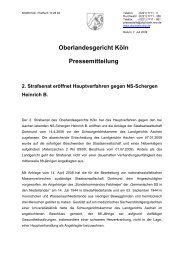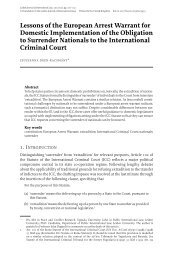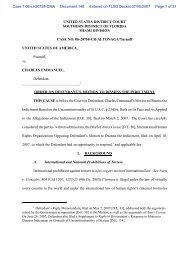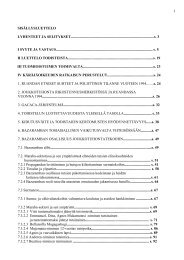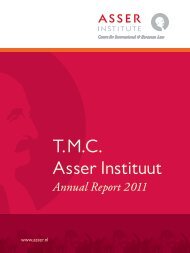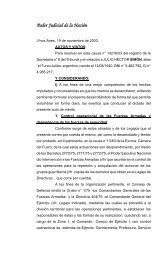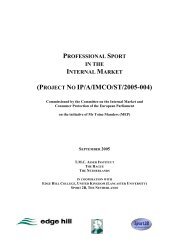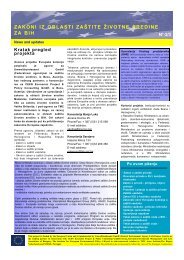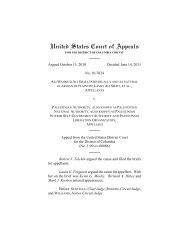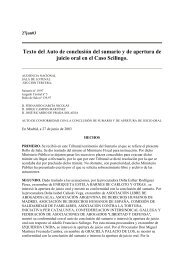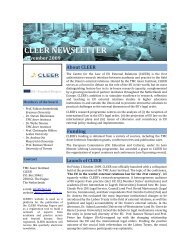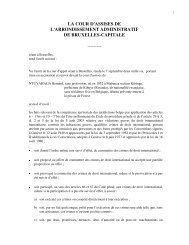Islj 2009 3-4 - TMC Asser Instituut
Islj 2009 3-4 - TMC Asser Instituut
Islj 2009 3-4 - TMC Asser Instituut
You also want an ePaper? Increase the reach of your titles
YUMPU automatically turns print PDFs into web optimized ePapers that Google loves.
A more basic question is what weight should be attached to the<br />
option transfer fee which assumed such importance in the compensation<br />
awarded by the CAS? Alternatively, what does an option clause<br />
for a transfer fee of €14 million in the loan agreement tell us about the<br />
value of Matuzalem? An option clause provides a party with an option<br />
to make a purchase. It constitutes a testing of the market. The party<br />
who has this option will take it up or it won’t. It will take it up if it<br />
believes that it is in its interests to do so, and vice versa. Lazio did not<br />
exercise its option clause rights. It decided it was not in its interests to<br />
affect a ‘definitive’ transfer of Matuzalem for €14 million.<br />
Economic theory postulates that value is determined by the intersection<br />
of the forces of supply and demand. If these two forces do not<br />
intersect there is no transaction; hence the good or service under consideration<br />
has no value. The €14 million was the supply price that Real<br />
Zaragoza placed on Matuzalem. It represents the price it wished to<br />
receive for him. Lazio was not prepared to pay such a price. There was<br />
no transaction and in the absence of a transaction it is impossible to<br />
prescribe any value for Matuzalem on the transfer market. This is the<br />
stuff of a tutorial in a first year economics course.<br />
The option fee represents an unsuccessful testing of the market;<br />
income that Real Zaragoza hoped to obtain for Matuzalem. What is<br />
disturbing here is that the CAS has accepted that what a club hopes<br />
to receive in a transfer fee in calculations concerning the value of a<br />
player. Moreover, this fictional transfer fee assumes the lion’s share (72<br />
per cent) of the compensation subsequently awarded. If the option<br />
transfer fee is subtracted from the amount the CAS awarded, ceteris<br />
paribus and ignoring the Palermo offer, the compensation payout is<br />
equal to €2,525,601. Revision Three. If the real transfer offer of Palermo<br />
(amortised over two years) is substituted for the option transfer fee<br />
used by the CAS, the payout would be equal to €5,986,268. Revision<br />
Four.<br />
The CAS included the three year contracts Matuzalem negotiated<br />
with Lazio, for the 2008/<strong>2009</strong> to 2010/11 seasons, and the first year of<br />
his first contact (the 2007/2008 season) with Real Zaragoza and the<br />
first two years of his second contract (2008/<strong>2009</strong> and <strong>2009</strong>/2010 seasons),<br />
which were amortised over two years and then averaged, 65 as an<br />
indicator of his worth as a player in the determination of its calculations.<br />
Under the terms of the loan deal between the two clubs he<br />
could not receive income from both contracts. The averaging of both<br />
helps to diminish criticisms concerning double counting. The values<br />
the CAS ascribed to these amounts, however, leads to a more fundamental<br />
problem.<br />
If Matuzalem had have played out his five year contract with<br />
Shakhtar Donetsk he would have been able to take up employment<br />
with another club free of the encumbrance of a transfer fee. He would<br />
have been a free agent. He unilaterally left Shakhtar Donetsk with two<br />
years remaining on his contract. Article 17 (1) says that one of the ‘particular<br />
criteria’ that needs to be taken account of in determining a<br />
compensation payout is ‘the time remaining on the existing contract’.<br />
66 This should mean, to the extent that Shakhtar Donetsk<br />
should receive compensation for income earnt by Matuzalem from<br />
other clubs, it should be for the 2007/2008 and 2008/<strong>2009</strong> seasons.<br />
The CAS inflated its calculations on income earnt during seasons<br />
after the expiry date of his contract when he could have become a free<br />
agent; and on fictional levels of income rather than what he actually<br />
earnt.<br />
65 Paragraphs 107, 108 and 177 of The<br />
Court of Arbitration for Sport, The<br />
Matuzalem Decision, 19 May <strong>2009</strong>.<br />
66 Article 17 (1), Federation International<br />
de Football Association, Regulations for<br />
the Status and Transfer of Players [1 July<br />
2005].<br />
67 Paragraphs 18 and 21 of The Court of<br />
Arbitration for Sport, The Matuzalem<br />
Decision, 19 May <strong>2009</strong>.<br />
68 Paragraph 131 of The Court of<br />
Arbitration for Sport, The Matuzalem<br />
Decision, 19 May <strong>2009</strong>.<br />
69 Paragraph 26 of The Court of<br />
Arbitration for Sport, The Matuzalem<br />
Decision, 19 May <strong>2009</strong>.<br />
70Paragraphs 20, 21 and 22 of the Court of<br />
Arbitration for Sport, The Matuzalem<br />
Decision, 19 May <strong>2009</strong>.<br />
71 Paragraph 131 of The Court of<br />
Arbitration for Sport, The Matuzalem<br />
Decision, 19 May <strong>2009</strong>.<br />
72 Paragraph 178 of The Court of<br />
Arbitration for Sport, The Matuzalem<br />
Decision, 19 May <strong>2009</strong>.<br />
73 Paragraph 138 of The Court of<br />
Arbitration for Sport, The Matuzalem<br />
Decision, 19 May <strong>2009</strong>.<br />
In the 2007/2008 season he received €1 million from Real Zaragoza<br />
and in 2008/<strong>2009</strong> €895,000 from Lazio. 67 If these two are summed<br />
and substituted for the fictitious earnings the CAS ascribed in its<br />
determination (€4,325,600) the compensation payout, ceteris paribus,<br />
falls to €9,428,333. Revision Five. If this revision is incorporated with<br />
those conducted above, the levels of compensation would be equal to<br />
€6,495,000 for the average of the amortised value of the Palermo<br />
transfer offer and the option transfer fee as calculated by the CAS<br />
(Revision Six); €4,361,666 for the average of the Palermo offer and one<br />
year amortised value of the option transfer fee (Revision Seven);<br />
€95,000 if both the Palermo offer and the CAS’s calculation of the<br />
option transfer fee are ignored (Revision Eight); and €3,555,667 if the<br />
Palermo offer is included and the option transfer fee excluded<br />
(Revision Nine).<br />
The CAS accepted that an amortised value of the transfer fee that<br />
Shakhtar Donetsk paid Brescia to secure Matuzalem, an amount<br />
equal to €3.2 million, should be incorporated into its decision. It<br />
refrained from doing so, however, because it was ‘able to calculate at<br />
the moment of the breach’ the value of the lost services which it<br />
claimed it incorporated in its decision making. 68 This statement is<br />
most ingenuous. Matuzalem breached his contract on 2 July 2007. 69<br />
The overwhelming majority of the CAS’s award - the option transfer<br />
fee negotiated between the clubs on 17 July 2008, Matuzalem’s three<br />
year contract with Lazio on 22 July 2008 and with Real Zaragoza on<br />
12 August 2008 70 - was based on developments which occurred many<br />
moments, more than a year’s worth, after ‘the moment of the breach.’<br />
A major problem with the CAS’s handling of the Brescia transfer fee<br />
offer is discerning whether transfer fees should be included or not,<br />
and if they are how they should be included in calculations of compensation.<br />
On one reading they should. On another they should not,<br />
if they have ‘been incorporated’ 71 with other factors in the decision<br />
making process.<br />
The CAS added €600,000 to its award because Matuzalem had<br />
abandoned Shakhtar Donetsk prior to the beginning of the UEFA<br />
Champions League. 72 It failed to provide any rationale (such as how<br />
his absence ‘changed’ the results of various games and the translation<br />
of this into a monetary amount - note here its problems in attributing<br />
a value for an equivalent or replacement player) 73 on how it<br />
arrived at this figure. Its failure to provide an explanation on this matter<br />
will require a resolution in future cases.<br />
Webster enunciated the principle that Article 17 (1) should apply<br />
equally to players and clubs and compensation payments should not<br />
be punitive or lead to enrichment. Matuzalem favours clubs over players<br />
and enables the enrichment of clubs that cannot be replicated by<br />
players. If Shakhtar Donetsk had unilaterally terminated Matuzalem’s<br />
contract he would have been entitled to receive €2.4 million, income<br />
owing to him on his contract. Matuzalem unilaterally terminated his<br />
contract and Shakhtar Donetsk was awarded €11,658,934. Matuzalem<br />
has developed principles which do not treat players and clubs equally<br />
and are punitive towards players. Can this be rectified?<br />
There are three ways in which clubs can end an employment relationship<br />
with a player. The first is to simply pay out his contract. The<br />
second is to unilaterally terminate the contract using Article 17 and<br />
wait for a ruling from the DRC or the CAS as to the level of compensation.<br />
With both these approaches the player would presumably<br />
receive the same level of compensation. If he finds himself terminated<br />
by the second option should he receive a top-up for the increased<br />
strain and the need to litigate to realise his rights over the more gentle<br />
termination of having his contract paid out? The third is to transfer<br />
the player to another club during the life of the contract and<br />
receive the concomitant payment of a transfer fee. This third option<br />
may provide a potential way for Matuzalem to be squared with Walker<br />
for players transferred to other clubs.<br />
This third option could be viewed as a club bringing about the<br />
constructive unilateral termination of a player’s contract. In the various<br />
ways that a club has available to it to influence the behaviour of a<br />
player, it can convince him that it is time to move on. When a player<br />
unilaterally terminates a contract, Article 17 assumes the club that<br />
takes up his employment is severally involved and jointly liable for the<br />
A RT I C L E S<br />
<strong>2009</strong>/3-4 25



